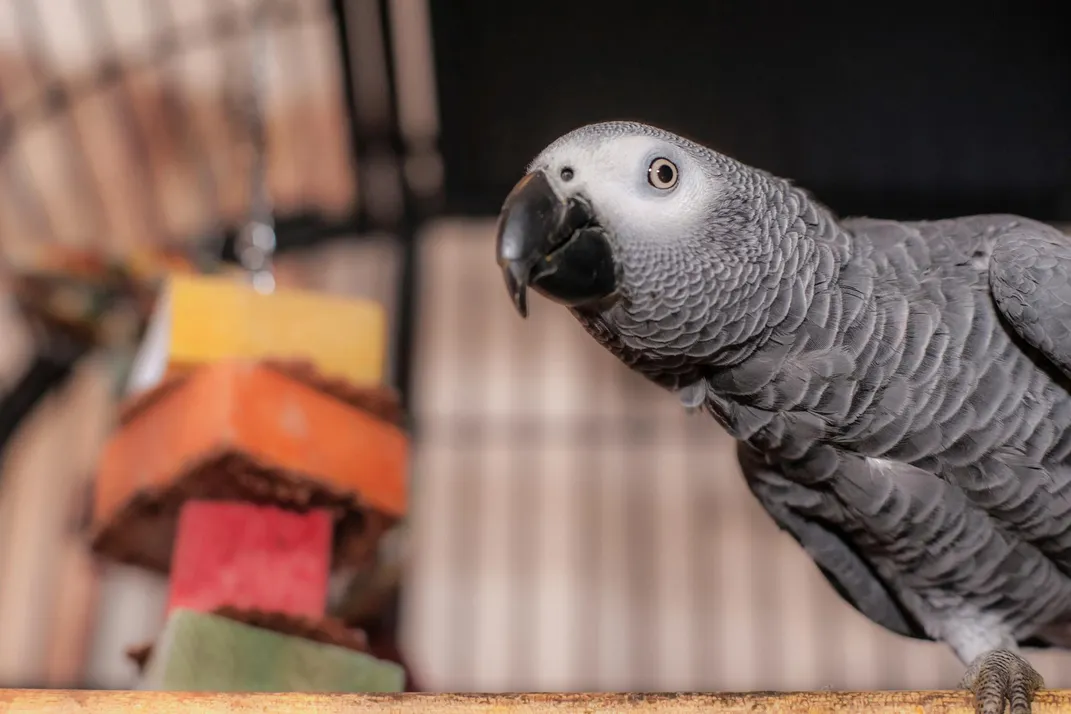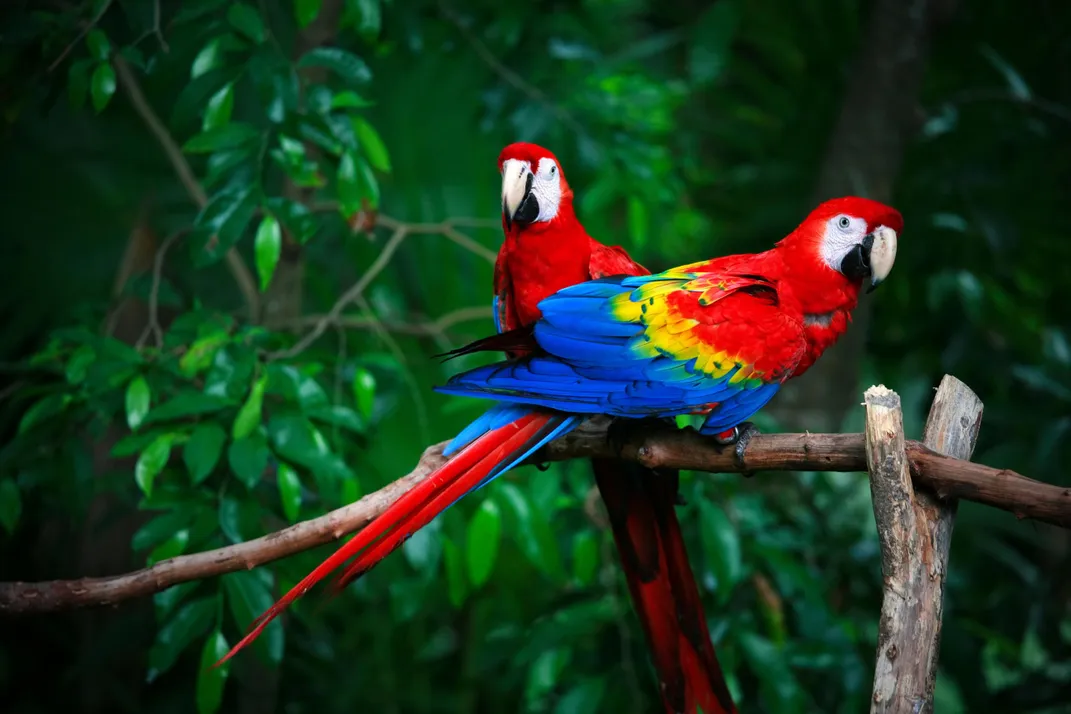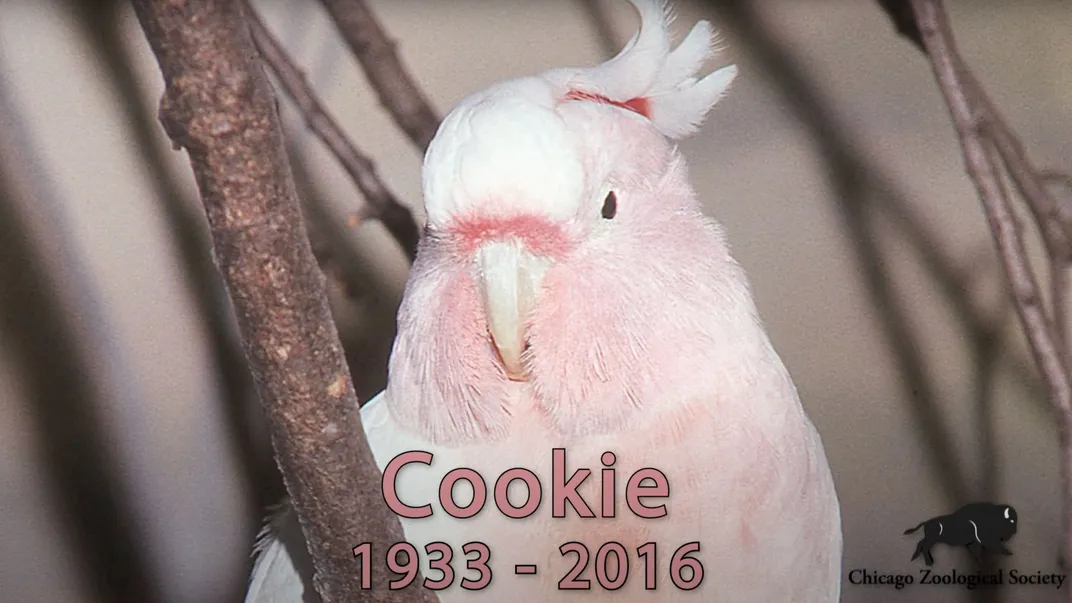14 Fun Facts About Parrots: They Can Sing, Use Tools and Live a Long, Long Time
And one species can even weigh as much as a house cat
:focal(800x602:801x603)/https://tf-cmsv2-smithsonianmag-media.s3.amazonaws.com/filer_public/75/13/7513c5a6-05d0-4f18-917b-a5b4942c5bf9/ara_macao_-fort_worth_zoo-8_web.jpg)
After dogs, cats and fish, birds are America’s fourth favorite pet. Over 7.5 million pet birds live in households across the United States, estimates the American Veterinary Medical Association. A great many of those feathered friends are part of the psittacine family—parrots—and no wonder: With their captivating colors, acrobatic antics and often silly personalities, the avian characters are hard to resist.
Parrots can be both incredible and demanding friends. For people more accustomed to fluffy mammalian companions, they can present some unexpected challenges. The long-living, intelligent and social birds need especially high amounts of attention and enrichment. Without it, they can become bored or stressed to the point of plucking out their own feathers with their strong, hooked beaks.
While some pet parrots come from local breeders, an exotic parrot trade network proliferates around the globe, contributing significantly to the decline of wild parrots and biodiversity in their native habitats. Thankfully, wild bird trafficking in the United States was tempered by the Wild Bird Conservation Act, passed in 1992, and restrictions imposed by the Convention on International Trade in Endangered Species, an international treaty that regulates importation of endangered flora and fauna.
Appearing on pirates’ shoulders, among Jimmy Buffett fanatics and in animal comedies, parrots have become zany characters in popular culture because of their tropical associations and mimicking abilities. In honor of the species behind “Polly wants a cracker,” here are 14 facts about parrots:
1. Some parrots can use tools.
One of the most famous parrots, Alex the African grey parrot, was said to have the intelligence of a human 5-year-old. He developed an emotional relationship with owner Irene Pepperberg; his last words to her were: “You be good. I love you.” Turns out, some of the psittacine tribe also possess quite practical intelligence.
Researchers at the University of York and the University of St. Andrews observed captive greater vasa parrots (Coracopsis vasa) using pebbles and the pits of dates to pulverize cockle shells. Male vasas ate the crushed powder, then offered a regurgitated calcium-rich snack to females before mating. Be thankful you get chocolates.
2. Parrots’ toes are made for climbing.
Like most other birds, parrots have four toes per foot, each ending in a sharp claw. But instead of the usual three-in-front-one-behind arrangement, parrot toes are configured for maximum grip: Two point forward, and two point backward—a configuration called zygodactylous. Along with beaks that can crack the world’s toughest nuts, parrots’ unique feet contribute to their eating abilities, as they can grab and hold food with their toes. Their unique claws also make parrots efficient, strong climbers.
3. Polly wants the mutton, too.
/https://tf-cmsv2-smithsonianmag-media.s3.amazonaws.com/filer_public/bd/3c/bd3c1305-596a-421e-a2a2-78f94c2f1873/nestor_notabilis_-fiordland_new_zealand-8b_web.jpg)
Many parrots are omnivores. They eat mostly plants—fruit, seeds, nuts—but will also consume insects and even meat. The South Pacific’s rainbow-colored lories and lorikeets, for example, feed almost exclusively on nectar, using tongues shaped like paintbrushes. Even these birds, though, have been seen eating meat at feeding stations in Australia. In New Zealand, native kea birds were first observed attacking, killing and eating sheep in 1868. The mountain parrots were persecuted as sheep-killers until 1986, when the species was granted protected status.
4. Not all parrots are tropical.
Of the roughly 350 known species of parrots, most live in the tropical and subtropical regions of Australia, Asia, Africa and the Americas. But some parrots fly off the beaten path. The keas, for example, live in alpine regions of New Zealand and nest in ground burrows, while the endangered maroon-fronted parrot dwells at 6,000 feet in Mexico’s Sierra Madre Oriental.
5. A third of the world’s parrot species face extinction.

Due to a combination of habitat destruction and persistent poaching for the pet trade, more and more species of parrots are landing on the International Union for Conservation of Nature’s Red List of Threatened Species. In Ghana, logging has destroyed 99 percent of the African grey parrot population. African greys are also one of the most desired species in the realm of parrot pets. Illegal capture and trade of the birds has heavily contributed to their dwindling numbers in the wild.
6. Unlike other birds, male and female parrots look alike.
/https://tf-cmsv2-smithsonianmag-media.s3.amazonaws.com/filer_public/cd/1c/cd1c78a5-3f93-40fb-89c9-a34decd2a6bf/eclectus_parrot_eclectus_roratus_-pair_web.jpg)
Males and females of most parrot species look virtually identical. It takes a keen eye—and usually a lab test—to distinguish a male from a female. But some species, like eclectus parrots, look so different across sexes that for a long time the males and females were thought to be distinct species of birds. The males sport emerald green feathers and flame-colored beaks, while females are crimson and royal blue, with black beaks and scarlet heads.
7. Parrots have taste.
While humans have up to 10,000 taste buds on their tongues, parrots only have about 350. For parrots, the buds are located not only on the tongue, but also on the back of the throat. The birds’ palates may not seem like much, but they’re functional: The birds can taste bitterness, which helps them avoid potentially poisonous foods, and sweetness. And, as parrot owners notice, the birds show preferences for certain foods.
8. The heftiest parrot weighs as much as a cat.
/https://tf-cmsv2-smithsonianmag-media.s3.amazonaws.com/filer_public/f1/6b/f16b43d1-a30e-49c6-a3f8-66bf9962ce45/hyacinth_macaw_anodorhynchus_hyacinthinus_in_flight_web.jpg)
Parrots come in an incredible range of shapes and sizes. The smallest psittacine species, the buff-faced pygmy, is nearly as small as a hummingbird. At about three inches long, it’s the average length of an adult human’s finger. The world’s longest parrot is the brilliant hyacinth macaw, which measures about 3 feet, 4 inches long from tip to tail. But New Zealand’s flightless, nocturnal kakapo wins the weight competition: A fully grown male tops out at nearly nine pounds—the average weight of an adult housecat.
9. Your pet parrot may outlive you.
Many parrots’ lifespans are comparable to humans’—a consideration many people don’t truly grasp when seeking a parrot as a companion. Larger species, like macaws and cockatoos, can live between 35 and 50 years in captivity. Tarbu, an African grey in England, lived to the ripe old age of 55. Cookie, a pink cockatoo living at Chicago’s Brookfield Zoo, was the oldest parrot in captivity until he died at nearly 83 years old in 2016.
10. Parrot feathers contain antibacterial pigments.

Parrots’ beautiful plumage isn’t just for looks; their feathers have a special defense against damage. Psittacofulvin, a bacteria-resistant pigment that only parrots are known to produce, give the birds’ feathers their red, yellow and green coloration. In a 2011 study in Biology Letters, researchers exposed different colors of feathers to a damaging bacteria strain, and they found the pigments actually helped protect the glorious plumage from degradation.
11. Parrots travel, too.
Though most parrot species occupy the same homeland throughout each year, several Oceanic species spend their winters somewhere different. The blue-winged parrot, swift parrot and orange-bellied parrot all breed in Tasmania, but come winter—March or April, down under—they migrate across the Bass Strait to mainland Australia. The blue-winged is currently classified as a vulnerable species, while the swift and orange-bellied species are unfortunately critically endangered.
12. They don’t just talk. They sing.
Parrots are famous for being commonly chatty, but a cheery blue parakeet named Puck earned a special distinction in diction. A bird of the budgerigar species, Puck was owned by Camille Jordan in California. In 1995, he landed in the Guinness Book of World Records for his vocabulary skills: He knew 1,728 words.
Many other parrots have also made news with their verbal abilities. Amazon parrots are renowned singers, including Groucho, who entertained audiences with songs like “How Much Is That Doggie in the Window.”
13. The psittacine family has a black sheep.
/https://tf-cmsv2-smithsonianmag-media.s3.amazonaws.com/filer_public/a0/4d/a04d3194-3cfd-47a9-8e67-e1ab1ad0767a/probosciger_aterrimus_-side_-upper_body-8a_web.jpg)
Native to rainforests in the South Pacific, the black palm cockatoo is the only cockatoo species with (almost) all dark feathers. Native to Australia, the black palm is also one of the most difficult birds to breed and raise in captivity; it is not naturally an affectionate bird. The cockatoos lay only one egg per clutch (nesting attempt), and chicks often die around 1 year of age—even wild pairs have difficulty rearing chicks.
14. Wild parrot behaviors remain mysterious.
Parrots have always been difficult to study in the wild: Many live in remote, inaccessible areas, like jungles filled with thick vegetation. Researchers have attempted to study parrots’ habits by attaching GPS trackers to them, but the birds can skillfully remove such unwanted accessories from their bodies. A 2015 study published in the Auk, though, was a breakthrough in tracking methods for elusive psittacines. By encasing GPS trackers in bite-proof plastic, researchers were able to track a group of keas in New Zealand without any obvious negative effects on the birds.



/https://tf-cmsv2-smithsonianmag-media.s3.amazonaws.com/accounts/headshot/Michelle-Donahue.jpg)
/https://tf-cmsv2-smithsonianmag-media.s3.amazonaws.com/accounts/headshot/Sonja_headshot.png)